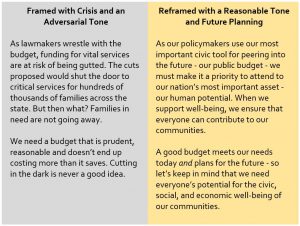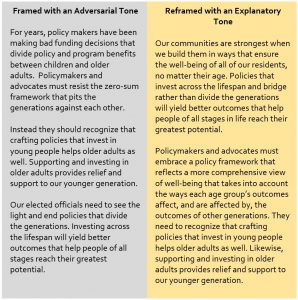Bringing the Public into Budget Conversations
February 23, 2017This time of year finds the human service sector focused on engaging the public around budget decisions taking place in statehouses and in Washington, DC. We all know that rallying public support for budget priorities can be tricky. Luckily, research from the FrameWorks Institute can help us be more intentional in how we go about navigating conversations about funding.
In an investigation into how to help Americans think more productively about public budgets, FrameWorks found that people default to little-picture, short-term thinking. Shifting the perspective to a longer-term view is therefore a key strategy.
In particular, FrameWorks recommends:
- Using the themes of Responsible Management and Prevention to make the case for funding priorities: the responsible thing to do is to take steps today to address needs we can see ahead.
- Take the time to define a “good” budget. Convey that a sound public budget looks ahead and helps a community plan and prepare for the future, as well as meet current needs.
- Maintaining an explanatory tone. We know you’ve heard this from us before, but it is worth repeating. There are times and ways that policymakers need to be held accountable, yet it is also important to avoid reinforcing dominant beliefs that the government is wasteful, inept, or corrupt.
In addition to applying the Building Well-Being Narrative to advocacy communications, we recommend incorporating FrameWorks’ extensive guidance on engaging the public on budget and tax issues. You might want to get started by reading “The Case against Rainy-Day Framing of Budgets and Taxes,” in Nonprofit Quarterly.
Following are some examples of budget advocacy communications that FrameWorks reframed for us incorporating their findings on human services and on public budgets. We encourage you to borrow language from the reframed examples in your communications.
Example #1

Example #2


